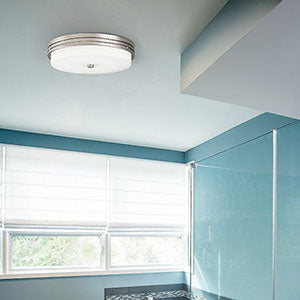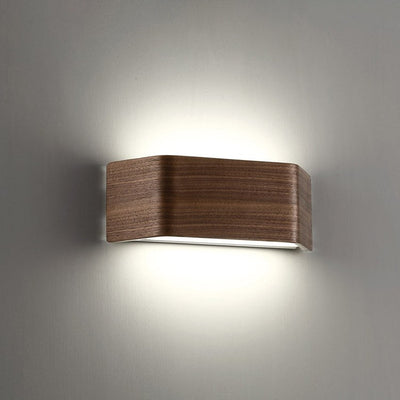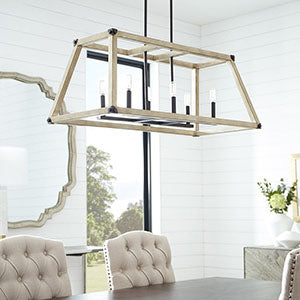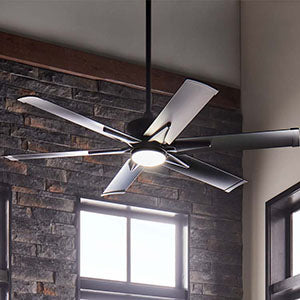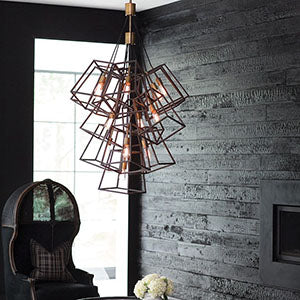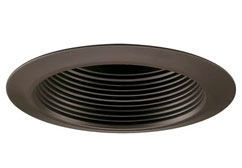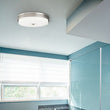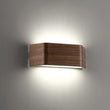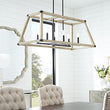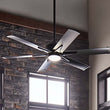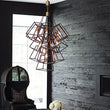Lighting
The Essential Guide to Vanity Lighting: Getting Your Bathroom Lighting Just Right
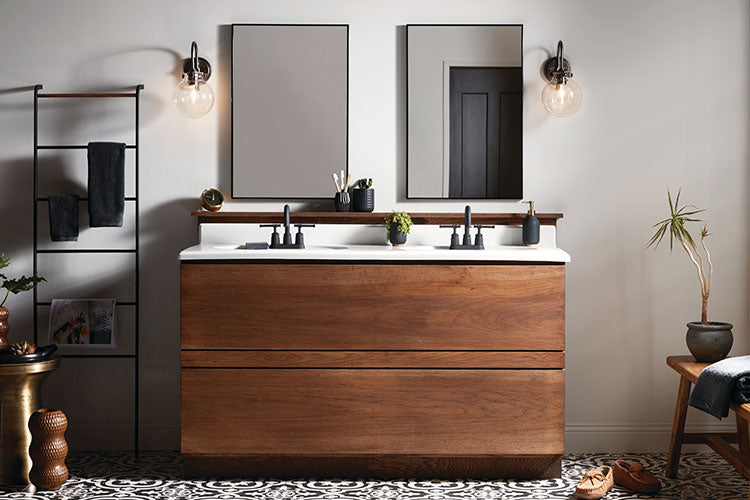
Bathroom remodels are now the most popular home project.
We start and end our days before our bathroom mirrors. Whether it's brushing our teeth, combing our hair, washing our face, putting on makeup, or shaving — vanity lighting helps us get ready to face the world or hit the pillow.
If you're redesigning your bathroom, you're in good company. Bathroom remodels are now the most popular home project, surpassing kitchens in recent years. And beyond a style boost, bathroom renovations increase the value of your home up to three percent.
In any bathroom remodel, vanity lights take center stage. Read on for answers to the most common questions about bathroom vanity lighting, and learn how to get this essential design choice exactly right.
What is Bathroom Vanity Lighting?
Vanity lighting refers to the lighting fixtures that illuminate the space in front of your main bathroom mirror above your sink (or sinks). Vanity lights are usually mounted above or on either side of the mirror, or both above and to the sides.
Vanity lighting is task lighting. It should be bright and targeted, so you can see what you are doing without distracting shadows. Vanity lighting helps with:
- Reading the fine print on medicine bottles and personal products
- Makeup application
- Shaving
- Skincare routines
- First aid
- Dental care
- Inserting/removing contact lenses
- Fixing small, broken items
- Accessorizing
- Cleaning eyeglasses and personal care items
What Type of Lighting is Best for Bathroom Vanities?
Vanity lighting has two main functions in a bathroom: (1) deliver the best lighting for makeup application and grooming while eliminating shadows, and (2) contribute to light layering in the room. There are three main types of vanity lights that provide the ideal bathroom mirror lighting:
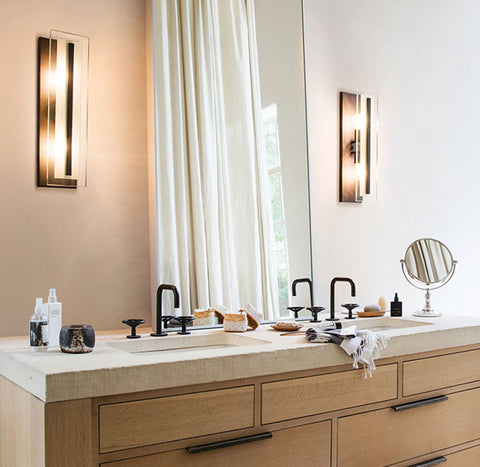
Inline vanity lights ooze style while bathing you in warm light.
-
Wall sconces
Despite different looks and styles to match every taste, the basic concept of a sconce remains the same: a light (or set of lights) mounted on a wall with a decorative bracket. Wall sconces bring light exactly where you need it and are typically placed on both sides of the vanity mirror. -
Inline vanity lights
This lighting style typically showcases a row of bulbs (exposed or covered with glass or fabric shades). Alternatively, inline lights can be a long, linear fixture with a single covered tube bulb. Inline vanity lights ooze style while bathing you in warm light. Most are mounted vertically on both sides of the mirror, or horizontally above the mirror to focus light where needed for your morning and evening rituals. -
Pendant lights
These are a distinctive choice that veer from classic bathroom lighting choices. Pendant lights hang from a rope, chain, or stem mounted on the ceiling, and come in many forms including single-light globes and domes, linear lights, full-size and mini chandeliers, and hanging lanterns. Swapping out pendant shades can have a significant impact on the warmth of the light and the overall style of your bathroom.
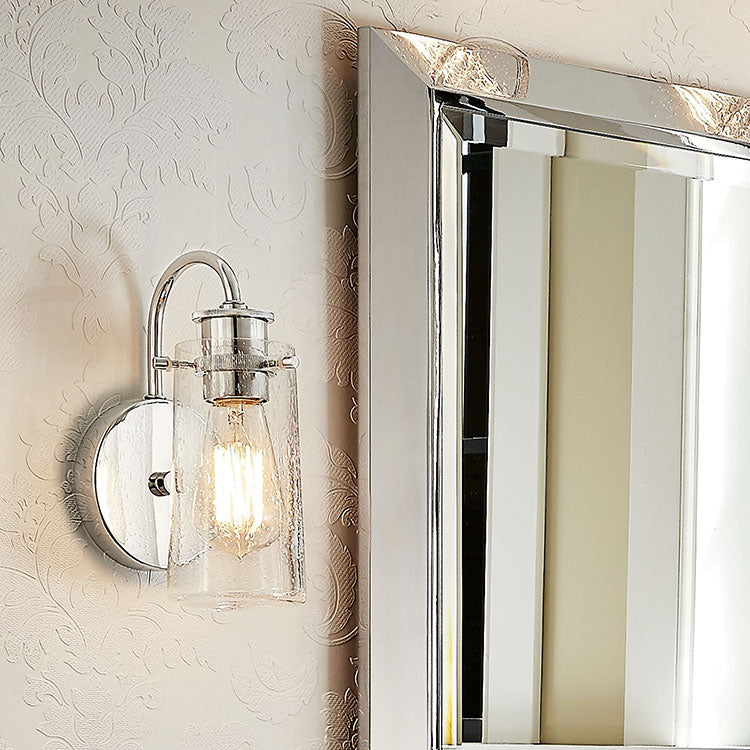
Swapping out pendant shades can have a significant impact on the warmth of the light and the overall style of your bathroom.
Should Vanity Lights Face Up or Down?
Vanity lights that face up create a softer light, somewhere between ambient and task lighting. The light reflects off the ceiling, which diffuses some of the brightness. If you select this style, you will want a brighter task light option, such as sconces on either side of the mirror.
Downward-facing vanity lights provide focused brightness and can serve as the only lighting around your vanity. This positioning can cast shadows, however, so add other lighting at the sides to fill in shadows. These lights can go beside the mirror, or on walls next to the vanity area.
Backlighting is another excellent way to improve lighting around the entire vanity area. Downward-facing lights (think pendants, chandeliers, or wall sconces) placed above and behind where you stand at the vanity are ideal.
Linear inline vanity lights don't face up or down, and can be mounted horizontally above a vanity mirror, or vertically on both sides. Either orientation helps eliminate shadows while providing balanced illumination.
Should Vanity Lights Hang Over the Mirror? Getting the Placement Just Right
This is the classic location for vanity lights, but modern lighting choices give you plenty of alternative positioning options. Here are the benefits of each location:
Over the mirror
This traditional location provides a full light for tasks, and is often the only option in powder rooms where the vanity and mirror fills an entire wall (leaving little room for sconces on the sides), and in master baths with one mirror above a double vanity.
Since your average bathroom vanity is 36 inches tall, you should center your lights over the sink above the mirror about 40 inches above your vanity top, or 76 inches above the floor.
For a minimalist, modern effect, install a row of recessed lights in the ceiling above the sink instead of placing a fixture above the mirror.
To the side of the mirror
Placing two sconces, one on each side, is a great way to eliminate shadows. For double vanities with two mirrors, use three lights total with one in between. You can even use hanging pendant lights in place of the sconces if wall mounting presents a problem.
Place your sconces or pendant lights between 65 and 70 inches above the floor, or at about eye level. Exactly how far apart they are will depend on the size of your mirror. But a critical design decision is how far to place the fixture from the edge of the mirror. Often, you'll want to allow a few inches of space so that the paint or wallpaper is visible between the mirror and the light. Whatever you decide, make sure the space is the same on both sides.
How Wide Should Vanity Lights be Compared to the Mirror?
When placing vanity lights above a mirror, shoot for a fixture that's one-third the width of your mirror at minimum to prevent a mismatched, unprofessional look. Similarly, your bathroom won't look polished if your linear light fixtures extend beyond the width of the vanity mirror.

Shoot for a fixture that's one-third the width of your mirror at minimum.
There can be two, six, or more lights on inline fixtures, and linear lights vary widely in width (or length, if positioned vertically). You should be aware of the measurements of your vanity mirror when choosing vanity lights, and vice versa.
Choosing the Best Vanity Lighting for Your Bathroom: Discover Your Preferred Lighting Style
Which vanity lighting style is right for you and your home? If you have a clear vision of your style, go ahead and jump to the next section. But if you're not sure of your preference, take a moment to explore these popular vanity lighting styles:
- Arts and Crafts - Attractive geometric designs with features reminiscent of handmade pieces of art. Sleek chrome or more traditional warm tones.
- Coastal - Nautical by nature, this style spurs visions of boats and shipyards and treasures of the sea.
- Contemporary - Clean lines and metallic finishes combine for impressive looks.
- Craftsman - Minimalism and a vintage feel are hallmarks, with a sprinkling of clear bulb designs.
- Farmhouse - Americana rules this style with a retro feel and weathered elements.
- Glamorous - Depth and beauty make these art deco and charismatic fixtures pop.
- Global - Brilliant design and opulence define this eclectic style.
- Industrial - Metal and wire, sharp angles with smooth curves, and architectural elements are the perfect complement to an urban aesthetic.
- Modern - Innovation runs rampant from metal framing to sculptural arcs to attractive spheres.
- Rustic - Textured materials give traditional candle holder-style a modern twist.
- Traditional - Classic finishes and charming touches make for a vintage feel.
- Transitional - A wide array of glass colors and mixed materials deliver crossover appeal.
What Are the Best Light Bulbs for Vanity Lighting? All About Bulbs
Vanity light bulb options include halogen, LED, and filament incandescent bulbs. Each delivers a unique light quality, which you can refine with glass color, frosting, and shade options. Here's what you need to know about light bulbs for your bathroom:
Halogen bulbs
These bulbs emit warm, bright light in a color spectrum close to that of the midday sun, resulting in the best color rendering index (CRI) for realistic colors. They have crisp quality that lends itself to detailed tasks, such as applying makeup and first aid.
Halogen bulbs are a little more expensive than incandescent bulbs and come in two different voltages:
- 120-volt - Often referred to as 'line voltage,' these bulbs come in a variety of types providing powerful, long-lasting lighting. Use the PAR line voltage halogen in recessed lighting above the vanity. The double-ended T-3 version is perfect for wall sconces next to vanity mirrors.
- 12-volt - These low-voltage bulbs provide top-notch beam control in a compact package, mostly in smaller fixtures. Choose the PAR36 version for recessed lighting and the miniature T-4 for pendants hanging next to vanity mirrors.
LED lights
Perfect for the energy- and cost-conscious, LED lighting comes in a variety of bulb styles and cover options. They provide welcome energy and financial savings over time, and are cool to the touch when lit. LEDs are often used in downward facing sconces and pendants.
Incandescent bulbs
The classic bulb style, incandescent bulbs provide a high level of brightness and are used for both task and ambient lighting. Incandescents are the least energy-efficient bulb and require more frequent replacement than other bulb styles.
You can further control the quality of your bathroom lighting through shades and dimmers. Add pendant shades in off-white, gold, or yellow to give the light a warmer feel. Light blues and silver give the light a cooler tone. Add dimmer technology to keep things relaxed at night or convey that "bright and early" feeling in the morning.
Now that you've got a good handle on vanity lighting styles and location options, it's time to narrow down all the bright ideas you have for a perfectly lit vanity!

